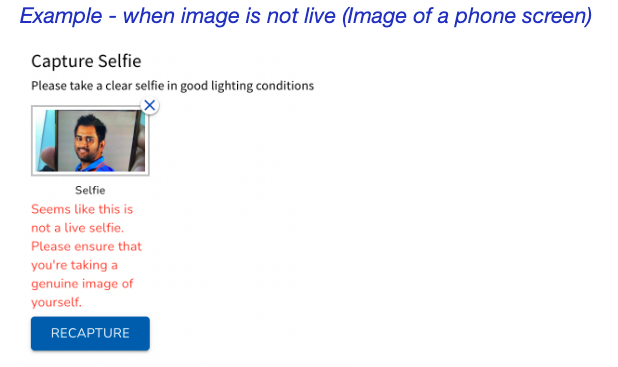What is face liveness detection?
Every time a business onboards a user via an automated verification journey, they use a live selfie to ensure a real-time interaction with the user. Here, they use face liveness detection to ensure that the user’s selfie is indeed live.
A liveness detection API detects fraudulent attempts like submitting a photo of a photo/screen/printout, a real-looking 3D layered image, a photo with an individual wearing a mask, etc.
Further, it also detects if a user’s eyes are closed or if there are multiple faces in the selfie. This is to ensure that a user’s selfie isn’t submitted without their consent. For example, in cases where one is sleeping or isn’t aware that their face is being captured.
Is capturing live selfies just a tick in the box or more?
When a user submits a live selfie for verifying themselves, their selfie may be used for other subsequent stages in the verification journey.
For instance, in BFSI, the selfie captured during liveness detection is also used to compare the user’s face with that on their government ID. Many organizations also use this selfie while saving the individual’s records for future use.
So, a live selfie doesn’t only ensure a live interaction, but also a seamless onboarding process for the user. One where the user doesn’t have to submit multiple pictures at each stage (face compare, audit, etc.)
Hence, the selfie submitted during an onboarding process not only has to be life but also optimal. By this, we mean that the selfie must be taken in good lighting, be clear, and be of a smaller size (in kb) to surpass poor networks. IDfy’s liveness API provides all the appropriate trigger warnings to ensure that the appropriate type of images is captured.
IDfy’s face liveness detection API

IDfy’s liveness API focuses on detecting fraud at source while ensuring that your genuine customers have a seamless experience. The way we do this is to focus on reducing false positives (where a genuine person is marked as “not live”) and reducing false negatives (where a fraudulent individual is marked as “live”)
Some of the elements that our API detects in a selfie are:
- Whether the image is live or not
- Whether there are multiple faces in the image
- Whether the individual’s eyes are open or not
- The distance of the individual from the camera
- Whether the individual is wearing a mask or not
- Good lighting and low image size for subsequent onboarding stages
These elements are keys in our API response, which can be used to provide appropriate error messages to the end users. Such as:



Here’s how we ensure a convenient user experience
We understand that a robust verification process shouldn’t be a hindrance to a great customer experience. So, we have specifically designed our API to deliver great accuracy and minimal turnaround time.
IDfy’s Liveness API is over 99% accurate based on both internal as well as external testing. Below are the accuracy stats for the API:
- The false positives percentage is less than 0.1%
- The false negative percentage is less than 0.9%
Our TAT is one of the best in the industry:
- P50 – 1.01 seconds
- P90 – 1.49 seconds
Apart from providing the actual liveness detection in the response, IDfy’s liveness API also ensures that the selfie is optimally clicked – this is incredibly important to ensure that the subsequent steps in your journey (for instance, a face match with a document, keeping customer record for future reference) happen seamlessly. Moreover, it ensures that your customer doesn’t need to click multiple selfies for various onboarding stages.
IDfy’s Face Liveness API is specially designed for poor network conditions. It performs ‘passive liveness’ – where liveness is calculated on the basis of a photo and not on the basis of a video. It is also optimized to perform accurately even in scenarios where the image size is just 200kb. This enables our clients to reduce the sizing of images to save on network unpredictability.
To know more about IDfy’s face liveness detection API, click here.

 Video KYC
Video KYC

